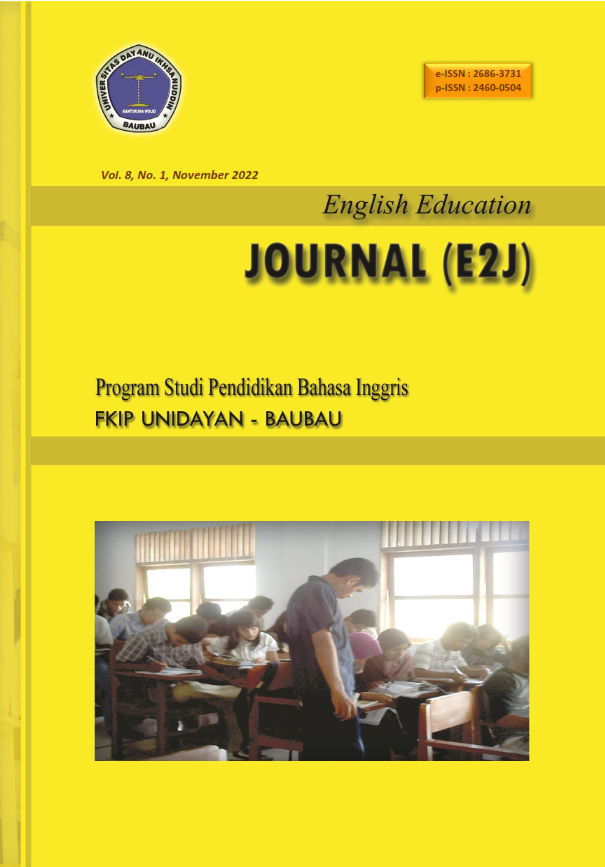Bahasa Inggris
DOI:
https://doi.org/10.55340/e2j.v8i1.847Kata Kunci:
reading anxiety, reading, comprehensionAbstrak
The objective of the research was to find out the level of students reading anxiety and students reading comprehension. Data collection in this research was carried out using a research instrument in the form of a questionnaire EFL Reading Anxiety Inventory (EFLRAI) consisting 23 items and test to determine the level of students reading anxiety and 30 items of reading comprehension test. The data obtained were analyzed by descriptive statistical analysis. Based on the result of the research, it was conclude that students’ reading anxiety was in the high category with the mean score 2.72 means in the high anxiety. Sequentially top-down reading anxiety with the mean score 2.77, bottom-up reading anxiety with the mean score 2.74 and classroom reading anxiety with the mean score 2.29. While reading comprehension the mean score 2.72 implies that the students’ reading comprehension is in the poor category.
Unduhan
Referensi
H. Aydoǧan and A. A. Akbarov, “The Four Basic Language Skills, Whole Language & Intergrated Skill Approach in Mainstream University Classrooms in Turkey,” Mediterr. J. Soc. Sci., vol. 5, no. 9, pp. 672–680, 2014, doi: 10.5901/mjss.2014.v5n9p672.
N. J. Anderson, “Metacognitive Reading Strategy Awareness of ESL and EFL Learners,” CATESOL J., vol. 16, no. 1, pp. 11–28, 2004.
F. Behjat, M. Yamini, and M. S. Bagheri, “Blended Learning: A Ubiquitous Learning Environment for Reading Comprehension,” Int. J. English Linguist., vol. 2, no. 1, pp. 97–106, 2012, doi: 10.5539/ijel.v2n1p97.
E. B. Bernhardt, Reading development in a second language: Theoretical, Empirical, and Classroom Perspectives. Norwood: NJ: Ablex Pub Corp., 1991.
F. Herawati, “The Relationship Between Students’ Anxiety and their Achievement in Reading Comprehension,” UIN Syarif Hidaatullah Jakarta, 2017.
A. Muhlis, “Foreign Language Reading Anxiety Among Indonesian EFL Senior High School Students,” ENGLISH Fr. Acad. J. English Lang. Educ., vol. 1, no. 1, p. 19, 2017, doi: 10.29240/ef.v1i1.160.
M. R. Jalongo and R. A. Hirsh, “Understanding reading anxiety: New insights from neuroscience,” Early Child. Educ. J., vol. 37, no. 6, pp. 431–435, 2010, doi: 10.1007/s10643-010-0381-5.
B. T. J. Huberty, “Test and Performance Anxiety,” pp. 12–16, 2009, [Online].
F. Nasution, “The Correlation between Students’ Reading Interest and their Reading Comprehension at The Second Year of SMAN 2 Tambang Kampar Regency,” UIN Suska Riau, 2019.
O. Pourkalhor and N. Kohan, “Teaching Reading Comprehension through Short Stories in Advance Classes,” Asian J. Soc. Sci. Humanit., vol. 2, pp. 52–60, 2013.
H. S. Alyousef, “Teaching Reading Comprehension to ESL / EFL Learners,” J. Lang. Learn., vol. 5, no. 1, pp. 379–380, 2006.
T. Rasinski and D. Brassell, Comprehension That Works: Taking Students Beyond Ordinary Understanding to Deep Comprehension, Grades K-6. Shell Education, 2008.
M. L. Pang, Elizabeth S.; Muaka, Angaluki; Bernhardt, Elizabeth B.;Kamil, Teaching Reading. Switzerland: International Academy of Education (IAE), 2003.
C. C. Snow, Reading for Understanding (Toward an R&D Program in Reading Comprehension). Santa Monica: RAND, 2002.
A. P. Johnson, Teaching reading and writing: A guidebook for tutoring and remediating students. R&L Education, 2008.
E. K. Horwitz, M. B. Horwitz, and J. Cope, “Foreign Language Classroom Anxiety,” Mod. Lang. J., vol. 70, no. 2, p. 125, 1986, doi: 10.2307/327317.
S. Pradhitan, “The Relationship between Students’ Anxiety and Their English Reading Comprehension,” p. 78, 2014.
S. Connelly, D. A. Simpson, and C. L. Petty, Anxiety Disorders (Psychological Disorders). New York: Chelsea House Publications, 2006.
J. Griffin, I. Tyrrell, and E. S. H. P. Winn, D. Chalvington, How to master anxiety: A practical handbook. Chalvington, East Sussex: HG Publishing.
Y. Saito, T. J. Garza, and E. K. Horwitz, “Foreign language reading anxiety,” Mod. Lang. J., vol. 83, no. 2, pp. 202–218, 1999, doi: 10.1111/0026-7902.00016.
W. D. Guimba and J. C. Alico, “Reading anxiety and comprehension of Grade 8 Filipino learners,” Int. J. Humanit. Soc. Sci., vol. 8, no. 3, pp. 44–59, 2016.
L. L. Chen, N. Maarof, and M. M. Yunus, “Factors Affecting ESL Reading Comprehension of Malaysian Secondary School Students,” pp. 542–547, 2016.
D. S. Dewi, “The Correlation Between Students’ Study Anxiety and Students’ Reading Comprehension,” Anglo-sax. J. Ilm. Progr. Stud. Pendidik. Bhs. Ingg., vol. 11, no. 1, p. 81, 2020, doi: 10.33373/as.v11i1.2405.
W. Grabe and F. L. Stoller, Teaching and researching reading, Second. Great Britain: Person Education Limited, 2011.






















